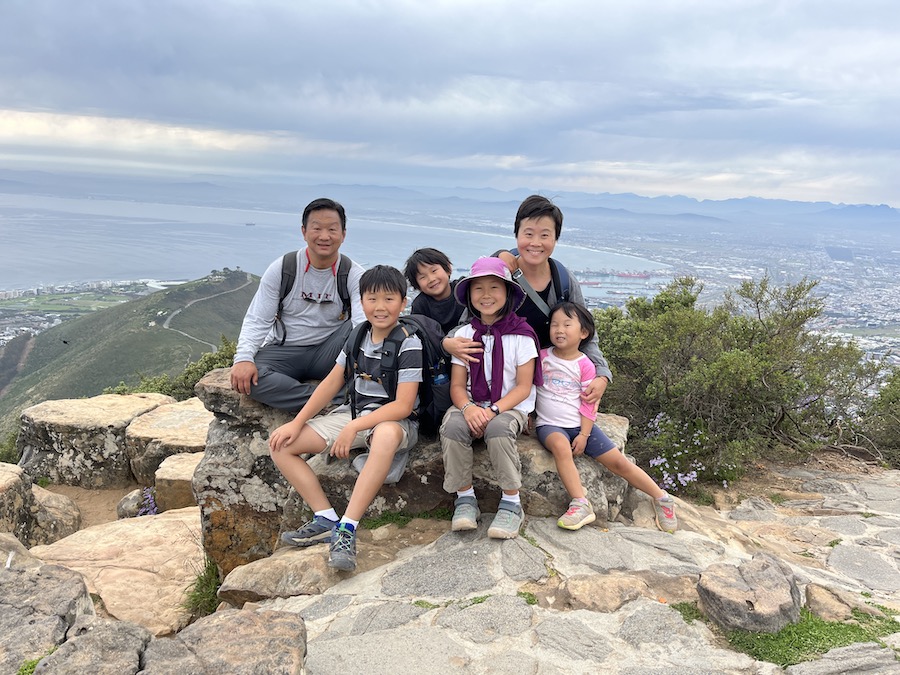Table Mountain is one of the most recognized landmarks in South Africa. It is a flat-topped sandstone plateau formed over millions of years, approximately 3 km from side to side, that overlooks Cape Town. The highest point on Table Mountain is 1,085 meters above sea level. Table Mountain is a World Heritage Site and is home to a diverse and unique array of flora and fauna. More than 70% of all the plants found on the mountain are endemic, meaning they are not found anywhere else in the world. Table Mountain National Park is the most visited national park in South Africa. Most visitors to the park ride the popular cable car to the top of Table Mountain for 360-degree views of the surrounding area.
Lion’s Head, a part of Table Mountain National Park, is a separate peak connected to the larger plateau of Table Mountain but slightly to the west. It is popular with locals as it promises the same spectacular views after a moderate 3.8 km hike to its summit. Plus, it is free!
We set off on the hike and conditions could not have been better. The weather was sunny but comfortable and the famous Cape Town breeze kept us cool. For much of the first part of the hike uphill, RY and EY raced ahead. We have found the people of Cape Town to be very warm and friendly and many hikers let us know that our two children were safe and doing great. We even met a nice Chinese lady who complimented RY on taking care of his younger sister so well. Along the way, we were able to have a little mini lesson on rocks and the rock cycle, which is part of the Year 3 curriculum that I used to teach. We examined the layers of sediment compacted over millions of years to form the sandstone (a type of sedimentary rock) that forms the geological structure of Table Mountain and Lions Head.
The last one-third of the hike required us to get on our hands and knees to ascend the ridge using a series of ladders, chains and staples. It was a bit unnerving as there were no safety guards and it would be totally possible for someone to slip and fall into the ravine below. Leo stayed with EY and made sure she was safe. The children absolutely loved the challenge and were not affected by the height or the potential dangers. It took us about two hours to reach the summit which offered amazing views. We braved the strong winds to enjoy our picnic lunch of sandwiches, oranges and chips.
The way down took nearly the same amount of time and was more tedious and altogether less thrilling. RY and AY raced ahead. DY provided a step-by-step guided tour, with non-stop narration, of the safe path down. EY slipped and took a small fall and later stepped into a puddle of water, soaking her shoes and socks so I carried her on my back for part of the way down, using two scarves to create a rudimentary carrier. In about two hours, we all made it to the bottom with sore thighs, knees and ankles.
We have done a number of family-friendly hikes since we have started our trip. Some that come to mind are Karura Forest in Nairobi and Ngare Ndare in Nanyuki, in addition to our bush walks in Masai Mara and Amboseli. This was the first hike that DY enjoyed from start to finish and did not complain. I think the reason is because this hike involved actual climbing, an element of danger and the exhilaration of reaching the summit. DY’s positive attitude toward this hike greatly enhanced our overall enjoyment of our time at Lion’s Head and made it a memorable experience for our family.
Author
-

Song is the mother of four children. She and her family have stepped away from it all and in September 2023, began traveling the world while homeschooling. Song is an ABC (American born Chinese) and has an undergraduate degree from Cornell and an MBA from Harvard. She is an entrepreneur and an educator. Her hobbies include learning, traveling, reading, cooking and baking, and being with children.

